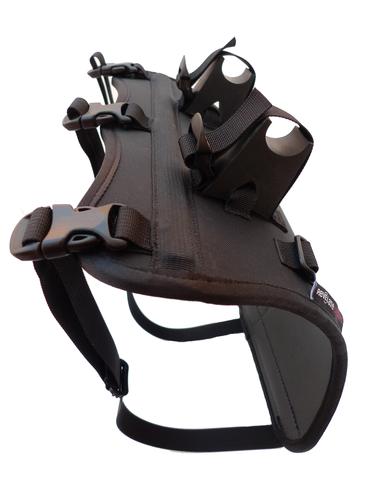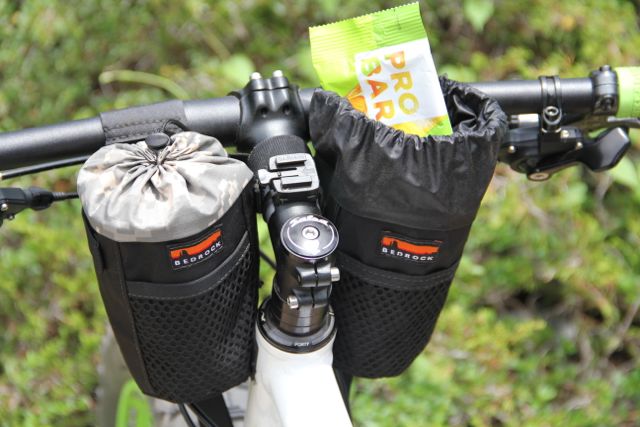There are really four major bags that comprise a complete system: Frame bag, bar bag, seat bag and accessory bags often referred to as feed bags or fuel tanks. Some riders opt for the whole enchilada and others get away with just a couple pieces. Much depends on the scale of your trips and how you like to travel.
Frame Bags
Like many bikepackers, I like riding a hardtail because it has a large main triangle ripe for a big frame bag. For those on full suspension bikes, that main triangle is often small and already used to house rear suspension mechanisms. This isn’t to say you can’t fit a bag in that space, but there won’t be much space left to be used. Many new bikepackers worry about displacing their water bottle cages to accommodate a frame bag. Worry not, a frame bag can hold more than enough water, and far better than two bottles. Because bike frames come in hundreds of different shapes and sizes, most frame bags are custom creations. Keep that in mind when you order your frame bag because the last thing you want to do is order a bag for a frame you plan to replace sooner than later. Another option to a full frame bag is a partial bag. Revelate Designs makes a bag called a Tangle Bag which is available in three basic sizes and hangs under the top tube providing a reasonable amount of storage. A full frame bag is often a better option as it’s the very bottom of the bag that is the most useful. That’s where I place the heaviest items, low on the frame where they are less likely to upset the balance of the bike. Top Tip: If you value your paint, be sure to use something like clear Frame Saver tape before mounting your frame bags. They can strip paint pretty quickly.

The Relevate Designs Tangle Bag is a simple and inexpensive solution.
Bar Bags
I have a love-hate relationship with bar bags. I love the utility and added capacity of a bar bag, but hate the placement of the weight and how they complicate an already tangled network of cables and brake lines. I consider a bar bag as overflow storage and if I can get away without one, I try to. When selecting a bar bag, be critical of how it mounts to your bars. A poorly made bar bag will wrestle with your cables and lines until something fails. It’s also important to select a bag capable of accommodating a varied amount of gear. Some bags are only useful when stuffed to the gills. Bags with rolled closures at each end are best as they can expand or contract according to volume needs. Many bar bags these days also accommodate additional bags like the Bedrock Bags Entrada and its optional exterior pocket. That is my preferred bar bag, by the way. Revelate Designs makes a bar mount system they simply call the Harness. It’s pretty clever and facilitates the use of a variety of different size bags and avoids crushing cables and lines as it mounts off the bars just slightly. Speaking of that, it may be necessary to reinstall longer cables and brake lines to best accept the addition of a bar bag. If it looks like your bag might bind or damage your cables and housings, it probably will. It’s not fun being miles from home without the ability to shift or brake.

Seat Bags
Seat bags are fantastic and should be one of the first pieces of gear you buy for bikepacking. They hold three to four pounds of gear with ease, stay put, and don’t really effect the bike like a bar bag. They put your gear out of sight, which somehow serves to keep it out of mind. I have used seat bags from Revelate Designs, Carousel Design Works, and my favorite by far is the Coconino Seat Bag from Bedrock Bags. Because a seat bag is anchored off the back of the seat, just hanging in space, it has to be well structured or it will wag around like a swollen tail. The Coconino bag is masterfully designed with stiffening panels in all the right places. It also has an ingenious mounting system that puts the load straps atop the head of the seatpost clamp and not levered off the back of the seat rails, which are easily bent. Seat bags almost always use a rolled closure which easily adjusts to big or small loads. Another critical design attribute of a good seat bag is the shape. It must have a well designed taper or it will bang into your legs. The Revelate Designs Viscacha and Porcelain Rocket Booster Rocket are excellent seat bags. Expect to fork over at least $150 for a good seat bag. My last top tip with regard to seat bags: Closely evaluate your seatpost clamp before you add another five pounds to your seat rails. Many of today’s seatposts have very small seat rail clamps. This puts excessive stress on seat rails. A larger clamp like those on a Thompson post will be more rail friendly. Breaking or bending a rail is bad news in the middle of nowhere, especially when it’s holding a third of your gear.

Feed Bags, Fuel Cells and Pouches
Bar and seat bags are usually the type of carrier that you don’t access during the day. Not to say you can’t but there are better ways to tote the things you need to have close at hand. The most convenient solution for those daily necessities are stem-mounted grab bags. The Wingate Stem Bag from Bedrock is great because it’s not overly large and has three mounting points to keep it from flailing around. I use those bags to store snacks, sunscreen and other essentials. Another good option is something like the Revelate Designs Jerry Can which mounts on top of the top tube against the seatpost. It’s surprising how much gear these small bags hold. It’s hard to go wrong with any of these small bags. Just make sure if you buy a frame mounted accessory bag that the mounting straps are compatible with the straps of your frame bag and not vying for the same attachment space.

Bag Options
Just a few years ago there were really only two choices for bags and wait times to get them were measured in months. That’s if you ever got them at all. These days there are a number of excellent craftsmen making bikepacking bags with unimpeachable quality. Because most of these bag makers are often one man shows, wait times can still be lengthy, so don’t wait until the last minute to place your order.
Having used a number of bags from different makers, I do have a personal bias towards Bedrock Bags of Durango. Used by many of the best bikepackers in the country, Andrew Wracher’s productions are testaments to his love of bikepacking and his unwavering attention to detail. Not just a great craftsmen, he’s a solid businessman and holds true to his quick delivery promises. The biggest name in bikepacking bags belongs to Revelate Designs of Anchorage, Alaska. Founder Eric Parsons started Revelate Designs (formerly Epic Designs) and quickly set the standard by which other bags would be measured. To meet demand for his bags, he partnered with Quality Bicycle Parts to have some of his bags manufactured on a larger scale making them more available to the consumer. The quality is top shelf and Eric’s designs are legendary. Other newcomers like Porcelain Rocket out of Calgary are carving a solid niche out of the market. Made by Scott Felter, Porcelain Rocket bags are highly regarded, but put your order in today if you want them. J.Paks of Denver is perhaps the newest brand on the scene and time will tell how they stack up to the bags already tested on epic rides from the Tour Divide to the Iditasport.
A good set of bags can make all the difference in how enjoyable your riding experience is. Choose your system carefully. Enjoy the experience of working with the craftsmen making these beautiful bags as all of them are as passionate about bikepacking as you will be the first time use put their bags on the trail.


